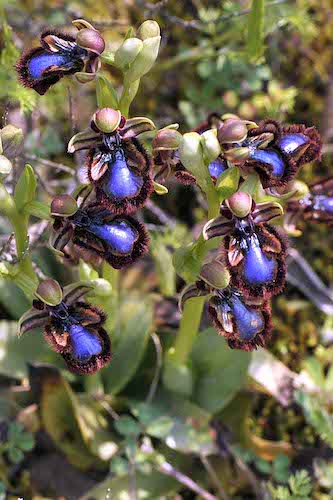(Mirror orchids)
These days its just one big wild orchid party on the island. Many orchids that live in groups colour the fields with white or purple; other orchids, preferring their privacy, make their home amongst the greenery along the roads. This vast flower family has many different branches, from the bee-imitating orchis to the Serapias growing in abstract forms.
Testes
Cheeky fully Breasted orchids (Ophrys mammosa) shoot towards the sky, sometimes to over a meter high (just to be able to peer above the bushes surrounding them). Others, like the Milky orchid (Orchis lactea), hide within the prickly bushes from the sheep, who apparently have heard that orchids can be an aphrodisiac. It is good that these woolly ruminants do not yet know how to dig up the tubers from which the orchids sprout. These are the culinary part of the flower and its these sturdy double balls that inspired Theophrastus to name the plants orchis, the ancient Greek for ‘testes’. One use of these tubes is to brew saleppi, a drink that in Turkey and in Greece is also used as a replacement for coffee or as an aphrodisiac. To protect the orchids this drink is nowadays is outlawed in Europe.
The false myth of Orchis
According to Greek mythology there once was a half god, a young man named Orchis, who at a party given by Dionysos became pretty drunk and raped a priestess. Dionysos became enraged and had Orchis cut into pieces, each piece thrown carelessly into nature — there where the flesh kissed the earth, orchids sprouted. According to another myth Orchis’ genitals fell into the sea close to a rock on Cyprus. Through the mating of this piece of Orchis and the sea, Aphrodite was born. There she rose from the foaming waves to take her place amongst the Greek Olympic Gods.
Another even better story is that this myth about the origin of orchids may simply be a fabrication of the French writer Louis Liger, who published in 1704 a book called Le jardinier Fleuriste et Historiographe (The floristic and historical gardener), where this story was first to be read. Previously no Greek nor Roman writer from ancient times had ever named this Orchis and Liger’s story does resemble a lot the myth of Hyacinth, a young man who was killed by a jealous God, after which he was changed into a flower.
The big seducers
Orchids are big seducers, especially when attracting bees, for whom they change into ‘look-a-likes’. They fool other hunters also with their appearances. For instance Mirror orchids (Ophrys speculum) who, with their metallic blue flowers, cluster together, and from far away produce the illusion that there is a heap of shit surrounded by thick shit flies. But they do not smell, nor do they have an appealing scent to seduce. When you think you are seeing a field full of lovely scenting hyacinths, its actually the cream coloured Provence orchids (Orchis provincialis) that, whilst ever-so beautiful, offer no appeal to your sense of smell.
In my garden there are lots of Holy orchids (Anacamptis sancta), which are not my favourites because of their faded pink colour and their somewhat messy shape. I have more respect now for the angular and wayward Serapias; they stand in the greenery — like interesting works of art. But now I have found another ugly duckling. A very tiny orchid that does not seduce, but behaves like she doesn’t want to be seen: the Densely flowered orchid (Neotinea maculata). It looks just like a blade of grass, ending with some small frills, barely recognizable as little flowers. I probably have been trampling over them, not realizing they were orchids. They stand out because of their dotted rosettes.
The Himantoglossum-variant
Their counterparts are the Himantoglossum, whose early specimen (H. robertianum) flower as early as in February and the very last ones of this family (H. comperianum) can, with a bit of luck, still be found in June in the mountains. Because of their long, wild hairs, I call the later ones ‘rasta orchids’. I am now used to their huge appearance. Lately I thought I saw one, but the leaves were not normal. It took me at least ten minutes to finally realize that this was no Himantoglossum-variant, but simply sage (Salvia officinalis), that grows aplenty in my garden. Because of this hysterical orchid fever it is easy to forget that there are many other impressive flowers participating in the flower race on Lesvos.











